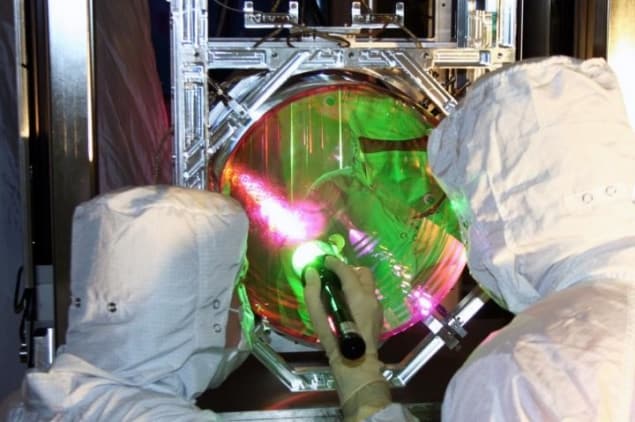
LIGO is designed to detect gravitational waves, but it is also proving to be a fantastic laboratory for pushing the limits of quantum physics. Now, an international team of researchers has cooled the interferometers’ large mirrors close to their quantum ground state. By cooling objects massive enough to potentially feel a detectable gravitational force, the researchers hope to open a new window into gravity’s possible effects on quantum mechanics. The work could also potentially lead to future enhancements in the sensitivity of LIGO to gravitational waves.
The two LIGO observatories (one in Louisiana and the other in Washington state) are famous for their pioneering detection of gravitational waves. In 2015, within days of being switched on, they spotted a signal from merging pair of black holes. Since then, LIGO has detected dozens of black-hole mergers and other events and has been joined in its search by similar instruments in Italy and Japan
Each LIGO detector is laser interferometer with arms 4 km long. Gravitational waves are ripples in space–time that change the relative path lengths in the arms of an interferometer, creating a tiny optical signal. The interferometers must have incredibly low noise to see these signals, which makes them great places to study quantum physics on a macroscopic scale.
Kilograms instead of nanograms
Elsewhere, several groups have published work describing the laser cooling of macroscopic oscillators to their motional ground states, but these have involved trapped objects on the nanogram or picogram scales. In this latest work at LIGO, researchers have looked at a composite object comprising four of an interferometer’s 40 kg mirrors, which together behave as an oscillator with a mass of 10 kg.
Laser cooling would not work for LIGO’s mirrors because the huge optical power required to trap such large objects would itself induce heating. Moreover, the mirrors’ low resonant frequencies would render laser cooling inefficient.
Instead, during what LIGO member Evan Hall of the Massachusetts Institute of Technology (MIT) in the US describes as “some extra time with the instrument when LIGO was on but not actively taking data”, researchers implemented a feedback cooling protocol. They measured the displacement of a mirror from sources such as the radiation pressure from the interferometer laser, before calculating the exact force needed to suppress these oscillations. This force was applied through the silica fibres to keep the mirror almost completely still.
Heisenberg compliant
As radiation pressure comprises the recoil from a stream of photons, applying active feedback to cancel this recoil might seem to involve violating Heisenberg’s uncertainty principle — which forbids knowing both the position and momentum of a particle simultaneously. “It’s not something physicists used to believe was possible 20 years ago,” explains Hall’s MIT colleague Vivishek Sudhir.
The key to experimental success was that the researchers could calculate the force from any given photon by measuring just its phase on impact: “You’ve got a complete record of all the disturbance caused on the mirror, and at that point nothing prevents you from using feedback to suppress the total motion of the mirror,” says Sudhir. This allowed the researchers to cool the mirror from room temperature to 77 nK – which is almost at its motional quantum ground state.

LIGO reveals quantum correlations at work in mirrors weighing tens of kilograms
The team now wants to push towards even colder temperatures. “The low hanging fruit in our experiment is to find what we can say about extraneous sources of decoherence that might prevent extremely large objects from being in pure quantum states,” Sudhir says.
Some theoreticians such as Roger Penrose have proposed mechanisms whereby gravitational fields lead to the collapse of quantum states: “One way to test [collapse theories] would be to have a massive system prepared in a pure quantum state, expose it to a gravitational field and see whether it decoheres,” says Sudhir; “With our work, it becomes possible to think of an experiment where you have an object in a pure, or at least reasonably pure quantum state, which is still massive enough to respond appreciably to gravity.”
Beyond this, he says, it might be possible to enhance the sensitivity of LIGO to gravitational waves, for example by placing the mirrors in entangled states. “It is not out of the question, but not any time soon.”
“Very cool”
“I think it’s a very cool [experiment],” says Hendrik Ulbricht of the UK’s University of Southampton; “The LIGO consortium have really studied this system over such a long period of time and they have such a good understanding of this experimental system and how it works.” He is “struggling”, however, with the idea that the system will be sensitive to gravitational effects on quantum mechanics: “If you want to look at quantum evolution, it is a dynamical measurement,” he says; “You need a system that is evolving according to quantum mechanics, and not according to the feedback you’re doing.”
Markus Aspelmeyer of the University of Vienna, whose group is testing for deviations from expected quantum behaviour in increasingly large objects – is more receptive to the notion of quantum behaviour being visible with the feedback switched on. “You constantly measure the system,” he says “The information you get you compare with a model of the system; the model is actually a stochastic Schrödinger equation.” Any deviations from the behaviour predicted by the Schrödinger equation should, therefore, be detectable immediately. He concludes that “it would be so cool to finally lay to rest all these collapse theories”.
The research is described in Science.



